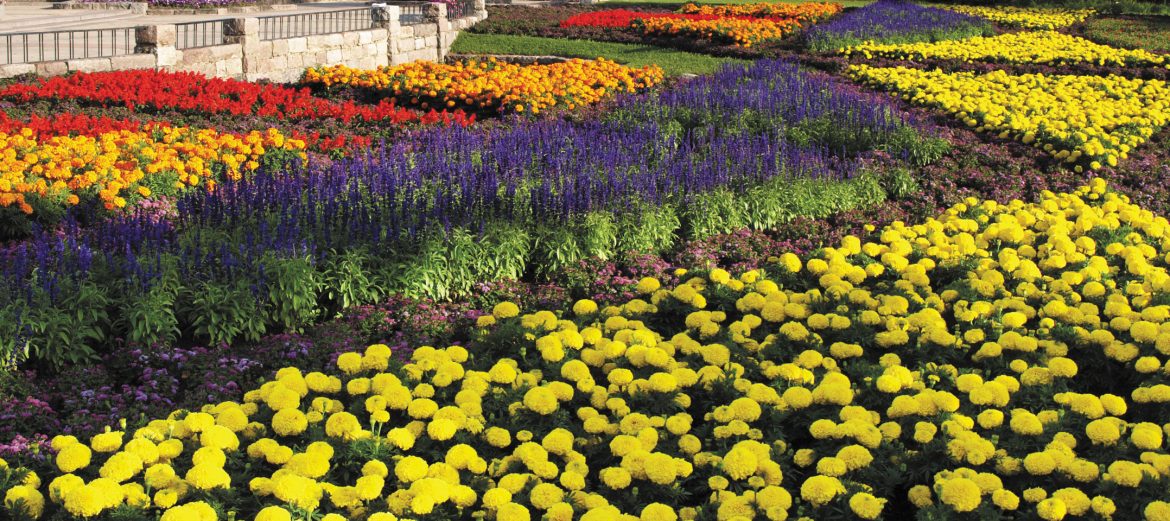Canada and the United States celebrate their friendship at this impressive preserve.
By Peggy Jordan, Associate Editor
July 2019
Minot, North Dakota, is approximately 80 miles from the Canadian border. It’s also that far from the International Peace Garden, which sits right where the two countries meet.
The garden’s flowers and forbs hit their full glory in August, when RVers will be attending FMCA’s 100th International Convention & RV Expo in Minot. Travelers will do themselves a favor by visiting this place to see the show.
Blooms fill a formal garden; brighten the earth beneath a huge, working analog clock; flow around a sunken garden; create a flags display (each country’s flag is represented in flowers); and even beautify a field crop area.
Among the plantings, memorials dot the place, marking time. A cairn at the entry gate was dedicated on July 14, 1932, the year the garden opened, by earnest souls unaware that another world war was coming. Likewise, the Peace Chapel, at the other end of the center garden, displays memorable quotes by philosophers, writers, and world leaders. And lest contemporary folk forget, a fragment of the World Trade Center that fell in September 2001 rests near the chapel.
Flowers, memorials, and sentiments . . . they remind us that peace is fragile, precious, and worth preserving.
Because the garden encompasses part of the international border, at a certain spot visitors can stand with one foot in the United States and the other in Canada. More fun discoveries await indoors. Plants from warmer parts of the world bask in a huge conservatory at the Peace Garden’s Interpretive Center. The conservatory’s variety of succulents and cacti is equally immense, featuring amazing shapes, sizes, and colors.
A restaurant and a gift shop also are inside the interpretive center.
From here, consider taking a driving tour to see more of the 2,400-acre preserve. The Canadian side is less developed and more natural, with a one-way road. You can stop and stretch your legs on a 1.5-mile hiking trail; enjoy a couple of picnic areas; and appreciate beautiful Lake Stormon. Back closer to the border, the road reveals the Willis Pavilion and a beautiful carillon tower from which bells chime on the quarter hour.
The two-way road on the American side leads to Lake Udall and attractions such as the Game Warden Museum. Entry is free to this hall, which honors the profession and educates visitors about the wildlife that game wardens help to protect.
The road next leads south to the campground. Near the entrance is a beautiful 1930s lodge constructed by the Civilian Conservation Corps; it was the first project built at the garden. Today it houses groups and events. Not far from the campground are two camp locations, which are used each summer: One is an athletic camp, and farther down the road is the site of the International Music Camp. Students of all ages and many nationalities study at the latter popular camp, which has sessions from mid-June to the end of July.
Campsites at the International Peace Garden are typically quiet, secluded by trees. Pets on leashes are welcome at the campground; they also are allowed at the gardens themselves, again, on a leash (no pets permitted inside the cactus conservatory). Most campsites easily accommodate full-sized Type A motorhomes and the vehicles they tow. However, only 30-amp electricity is available here. Reservations can be made online at www.peacegarden.com/camping/ or by phone at (888) 432-6733. It’s highly suggested you bring bicycles to take advantage of the parks’ miles of fantastic roads. And, several lakes at the garden can be explored with a kayak or canoe.
Canada and the United States have been friends for a long time, sharing sorrows and victories. With a visit to the International Peace Garden, you’ll agree the two countries also share a belief in the value of peace.
Details
International Peace Garden
www.peacegarden.com
(888) 432-6733
Canada:
10939 Highway 281
Boissevain, MB R0K 0E0
(204) 534-2510
United States:
10939 Highway 281
Dunseith, ND 85329
(701) 263-4390
Entry: Fee is $20 per vehicle. If you are towing a vehicle, the two count as one.
Customs: You do not need a passport to enter the Peace Garden, but it is recommended to have one to return to your country of origin. If you don’t have a passport, a government-issued photo ID, such as a driver’s license or other documentation, will be needed.
Important: Contact the customs office of the country you plan to re-enter or visit before you arrive, to be sure you have the currently required identification.
Canada Customs: (204) 534-6820
https://www.cbsa-asfc.gc.ca/menu-eng.html
U.S. Customs: (701) 263-4460
https://www.cbp.gov/travel/us-citizens#
Note: Both customs locations have duty-free stores.
To read more about Minot, North Dakota, site of FMCA’s August 14-17, 2019, convention, click here.


